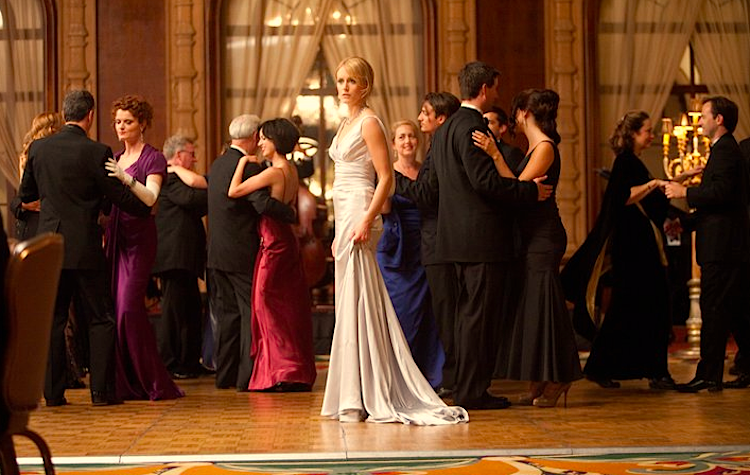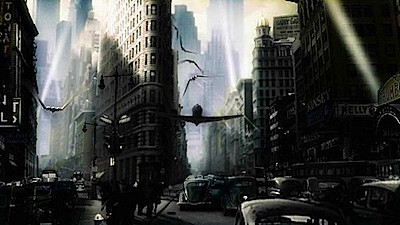
By Jason Apuzzo. I’ve been trying to crystalize my thoughts on the Atlas Shrugged trailer since seeing it Friday. As a coincidence, I recently finished reading Atlas Shrugged – for reasons other than the film’s release, as it turns out, but which nonetheless put me in the mood to see the trailer and get a sense of what the filmmakers had done with the material.
On seeing the trailer, something occurred to me that I’d mentioned to director Paul Johansson when we were on the film’s set – which is that Atlas Shrugged, which was first published in 1957, takes place in a kind of alternate, indefinite future. The precise nature of that future, its look and feel, struck me as being something that a filmmaker could exploit to great advantage, particularly in so far as Rand’s novel veers strongly toward dystopia late in the story – depicting death rays, fascistic military police, optical refractor beams, and the like. Reading the novel, it seemed to me that Rand’s story was rife with possibilities to create a filmic world similar to that of Fritz Lang’s Metropolis or Ridley Scott’s Blade Runner – albeit of a different, less nightmarish cast.

What complicates matters, of course, is that our vision of ‘the future’ circa 1957 was much different from our vision of the future today. Rand’s novel deals primarily with the railroad and steel industries, for example, industries that have lost their futuristic sheen amidst the successive eras of the Jet Age, Space Race and Information Age. (In fact, trains and steel had already lost their glamor, so to speak, by the time Rand wrote her novel.) Suffice it to say that today’s Hank Rearden would not likely be pouring steel; nor would Dagny Taggart likely be operating a railroad. Indeed, I suspect Dagny would be somewhere in Silicon Valley pushing forward the boundaries of the Information Age, while Rearden might be in a clean-room designing next-generation microchips.
This, ultimately, is why I think Atlas Shrugged – in order for it to be faithful – is probably best set during the 1950s, albeit in an ‘alternate’ version of the 1950s. I’m thinking here of something like the alternate version of the 1930s presented by Kerry Conran in his flawed but interesting fantasy epic from 2004, Sky Captain and the World of Tomorrow.
In that similarly low-budget effort, Conran used digital technology to create a stylish, alternate 1930s of flying robots, advanced Nazi superweapons, airplane-submarines and flying air bases in order to bring to life a fanciful story of how World War II ‘might’ have been fought, had a few scientific super-geniuses had their way. This, it seems to me, might’ve been a interesting approach to take with Atlas Shrugged. Ultimately, however, Paul Johansson never really had the opportunity to contemplate such an option – in so far as he was hired to direct Atlas Shrugged just over a week before cameras rolled, an extremely challenging situation for any director, let alone someone charged with a project of this scale.
I don’t think such a retro-futuristic approach would’ve made the film more expensive to do. It is, in fact, quite possible these days to create realistic sci-fi dystopias on a budget. To show one recent example of this, I’ve embedded below the trailer for award-winning writer-director-ILM visual fx designer Grzegorz Jonkajtys’ recent film The 3rd Letter (previously titled, 36 Stairs), about which I’ve posted here at Libertas previously.
The 3rd Letter takes place in a polluted, dystopian future-metropolis in which human beings depend on bio-mechanical alterations in order to withstand the deteriorating climate. The full film is about 15 minutes long, quite lavish in its visual design, and was apparently made on a budget of around $7000. The film quietly speaks volumes about where independent filmmaking is headed, in terms of how technology is currently able to support highly expansive visions.
Contrary to what many people have been saying, I don’t believe Atlas Shrugged is a project that needed a $200 million budget or the participation of Angelina Jolie/Charlize Theron to do it properly. What the film did need, in my opinion, was an audacious cinematic vision to match Rand’s own.
We’ll soon see if that’s what it got.
[Editor’s Note: It also occurs to me since writing this post that, if one were to ‘update’ Atlas Shrugged to the world of today, it would be interesting to have Dagny working in the post-9/11 airline industry, with Rearden providing lighter, stronger metals for her airplanes. Plus: imagine the fun one could have depicting the TSA.]
Posted on February 16th, 2011 at 11:26am.
Fantastic piece, Jason.
I’ve always seen Atlas Shrugged as traditional science fiction as well. Reardon’s metal, Galt’s invention, the government’s weapon of mass destruction — all sci-fi entities that are the center of the story both thematically.
The book even examines ramifications of such inventions, which I think gives it a home in the sci-fi category.
Obviously there’s political-science fiction as well: What happens when collectivist philosophies push too far? What would happen if the industrialists went on strike? Those are all fascinating questions.
I’m right with you on Sky Caption, too. When I saw the film, I immediately thought of Atlas Shrugged. I just watched the new Metropolis Blu, and I couldn’t stop thinking of Atlas Shrugged — of course, Ayn Rand was a huge fan of Fritz Lang, so that’s natural.
Thanks for the kind word, Vince!
Quick point on Fritz Lang: I’m convinced that Shrugged was deeply influenced by Metropolis, although I’ve never found any direct mention of the film in Rand’s letters or journals. The rhythms, tone and imagery of Shrugged seem highly cinematic to me – almost as if the novel was written to be adapted for the screen.
I can’t say anything about a possible Metropolis influence, but I believe that in terms of the “rhythms, tone and imagery of Shrugged” its greatest influence was literary — namely, Victor Hugo’s Les Miserables. Rand was huge fan of Hugo’s work in general and his masterwork in particular. The long speeches in Atlas Shrugged have their counterparts in Les Miserables — not speeches, per se, but long digressions about, e.g., the history of Paris sewers, or street blockade-building. (Which makes me wonder how the director will ultimately handle Galt’s three-hour speech.)
Yes, Hugo was also a big influence on her from everything I’ve read – particularly in terms of the vastness of Hugo’s social critique in Les Miserables. And there are certainly a few moments in Shrugged when Galt really feels like a kind of modern, transmuted form of Jean Valjean.
Suffice it to say that today’s Hank Rearden would not likely be pouring steel; nor would Dagny Taggart likely be operating a railroad.
Why not? Rand selected both of those industries because they form the backbone of a national economy. The most efficient movement of cargo is still by rail, and anyone who’s ridden AMTRAK in the last ten years knows how badly the rail infrastructure is faring these days. As for Rearden, materials science underlies all technology and a significantly lighter, stronger steel would produce a revolution in building, vehicular traffic flow and energy production/efficiency. We can live without the internet and faster computers, but not without the necessities of life that come over the railroad on rails of steel.
OK, maybe Rearden would be working in the airlines – where all of those technologies would come into play, as well. Think Richard Branson, by way of Steve Fossett.
Like I said earlier this feels like a rush job.(I’m aware there was legal issues at stake too) Which it really didn’t need to be even with the directer being hired just a week before production. Heck, Victor Fleming replaced two directors in 1939 and completed both movies on time and nearly simultaneously. Those two movies happened to be Gone with the Wind and The Wizard of Oz. For all of us that love the movies it sure be nice if Paul was the next coming of Victor Fleming. Also your points about updating the technology of the story from old line industries like steel and railroads is well taken. I agree or they needed to go retro and set the story in the time that the book depicts. The movie making technology exists to go either direction effectively.
Of course I think We need to reserve judgment until the movie is actually released. There’s too many people in this world and currently running this country that are philosophically opposed to Ayn Rand and will viciously attack this movie no matter how good it actually is. I can’t wait to read the New York Times review!
All points well taken. Incidentally, a few months ago I finished the new biography of Victor Fleming. He was quite a stud (both literally and figuratively) – and easily one of the greatest American directors. I highly recommend it if you’re interested in him:
http://www.amazon.com/Victor-Fleming-American-Movie-Master/dp/0375407480/ref=sr_1_1?s=books&ie=UTF8&qid=1297957394&sr=1-1
I’ve always been a fan of alternative histories. “Atlas Shrugged” struck me as being an alternate world where Hitler did not come to power and all of Western Europe had fallen to the Soviets politically. The US in the thirties flirted closely with socialism and if WWII had not occurred to bring us out of the Great Depression, America may have looked a lot like the America in “Atlas Shrugged”.
Yes, it does have that ‘alternate history’ quality. I think Rand was smart not to spell things out too specifically, in order to let the reader’s imagination fill out the scenario.